Strategic Management Analysis: A Case Study of the Nike Corporation
VerifiedAdded on 2022/12/19
|22
|6431
|4
Case Study
AI Summary
This case study provides a comprehensive strategic management analysis of Nike, examining its operations in the sports industry. It begins with an introduction to strategic management and the company's background, including its global presence and brand value. The analysis delves into Nike's current strategies, including its generic and intensive growth strategies, and identifies key strategic issues like increased competition and declining sales in the US market. The report explores the sports industry's competitive landscape, Nike's organizational structure, culture, and leadership. It includes a Porter's five forces analysis and a SWOT analysis to assess the company's competitive position, opportunities, and risks. The study also examines the company's strategy implementation, organizational culture issues, and key learning. The case study concludes with recommendations for improving Nike's strategic management processes and competitive advantage, aiming to help the company maintain its leadership in the sports apparel and equipment market.
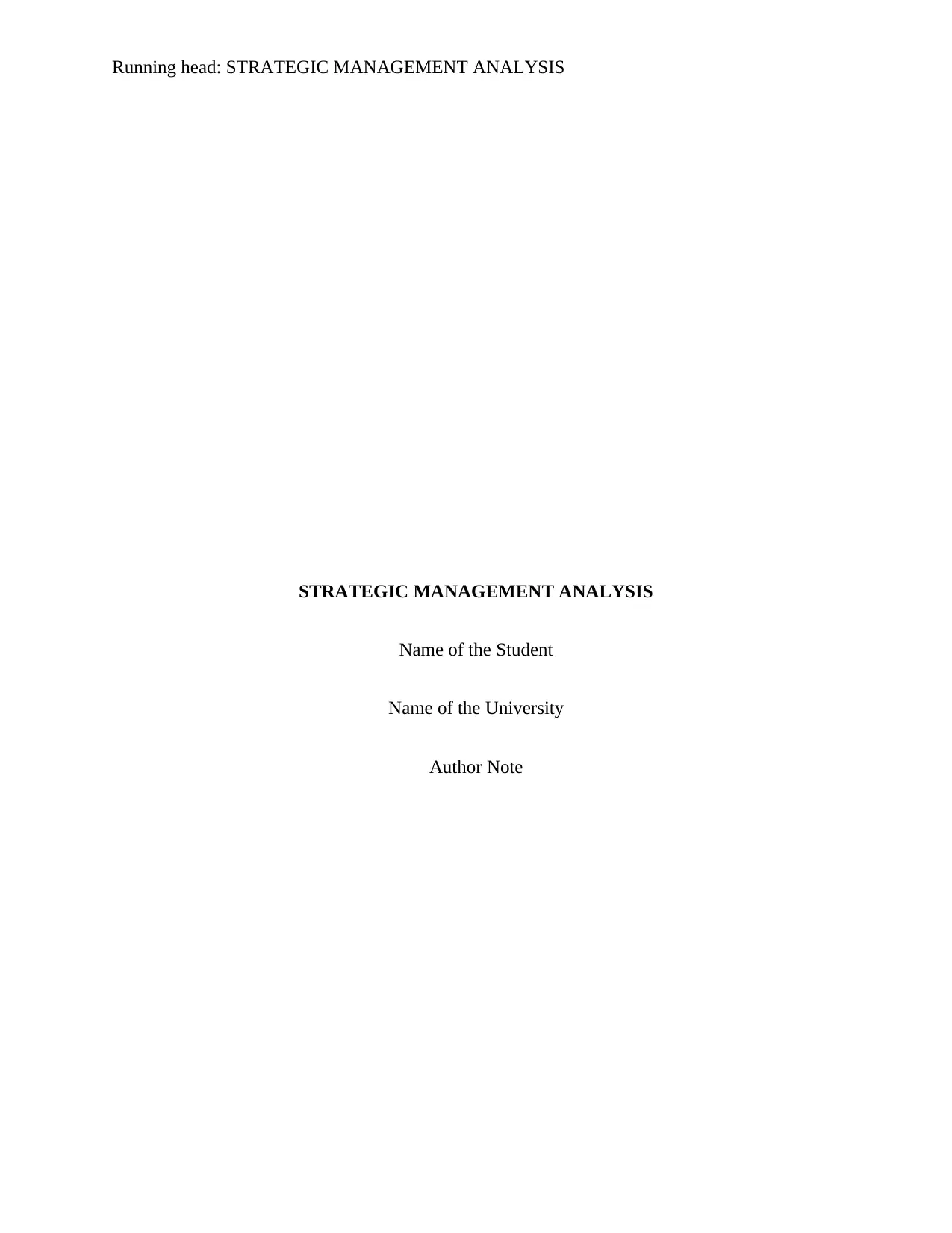
Running head: STRATEGIC MANAGEMENT ANALYSIS
STRATEGIC MANAGEMENT ANALYSIS
Name of the Student
Name of the University
Author Note
STRATEGIC MANAGEMENT ANALYSIS
Name of the Student
Name of the University
Author Note
Paraphrase This Document
Need a fresh take? Get an instant paraphrase of this document with our AI Paraphraser
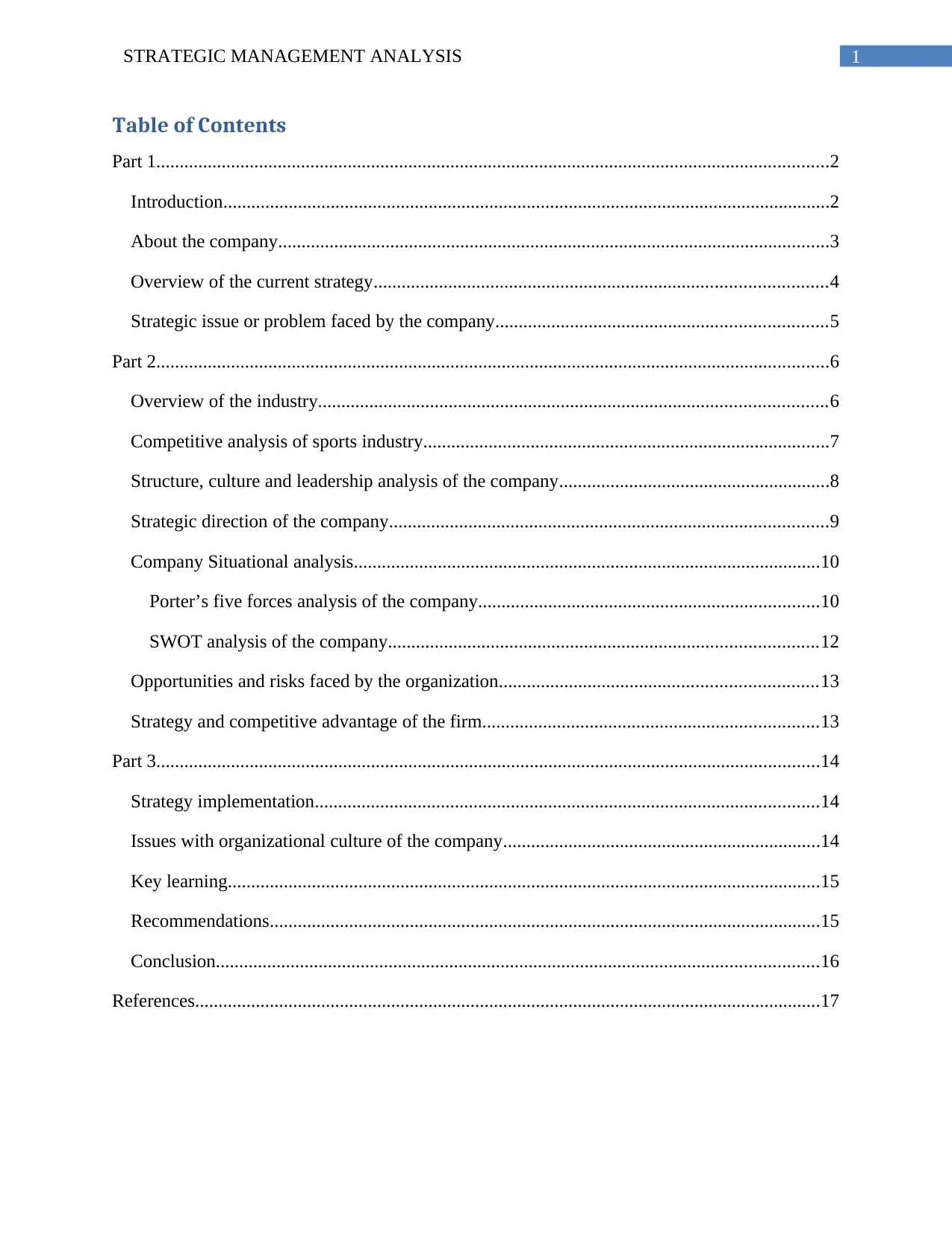
1STRATEGIC MANAGEMENT ANALYSIS
Table of Contents
Part 1................................................................................................................................................2
Introduction..................................................................................................................................2
About the company......................................................................................................................3
Overview of the current strategy.................................................................................................4
Strategic issue or problem faced by the company.......................................................................5
Part 2................................................................................................................................................6
Overview of the industry.............................................................................................................6
Competitive analysis of sports industry.......................................................................................7
Structure, culture and leadership analysis of the company..........................................................8
Strategic direction of the company..............................................................................................9
Company Situational analysis....................................................................................................10
Porter’s five forces analysis of the company.........................................................................10
SWOT analysis of the company............................................................................................12
Opportunities and risks faced by the organization....................................................................13
Strategy and competitive advantage of the firm........................................................................13
Part 3..............................................................................................................................................14
Strategy implementation............................................................................................................14
Issues with organizational culture of the company....................................................................14
Key learning...............................................................................................................................15
Recommendations......................................................................................................................15
Conclusion.................................................................................................................................16
References......................................................................................................................................17
Table of Contents
Part 1................................................................................................................................................2
Introduction..................................................................................................................................2
About the company......................................................................................................................3
Overview of the current strategy.................................................................................................4
Strategic issue or problem faced by the company.......................................................................5
Part 2................................................................................................................................................6
Overview of the industry.............................................................................................................6
Competitive analysis of sports industry.......................................................................................7
Structure, culture and leadership analysis of the company..........................................................8
Strategic direction of the company..............................................................................................9
Company Situational analysis....................................................................................................10
Porter’s five forces analysis of the company.........................................................................10
SWOT analysis of the company............................................................................................12
Opportunities and risks faced by the organization....................................................................13
Strategy and competitive advantage of the firm........................................................................13
Part 3..............................................................................................................................................14
Strategy implementation............................................................................................................14
Issues with organizational culture of the company....................................................................14
Key learning...............................................................................................................................15
Recommendations......................................................................................................................15
Conclusion.................................................................................................................................16
References......................................................................................................................................17
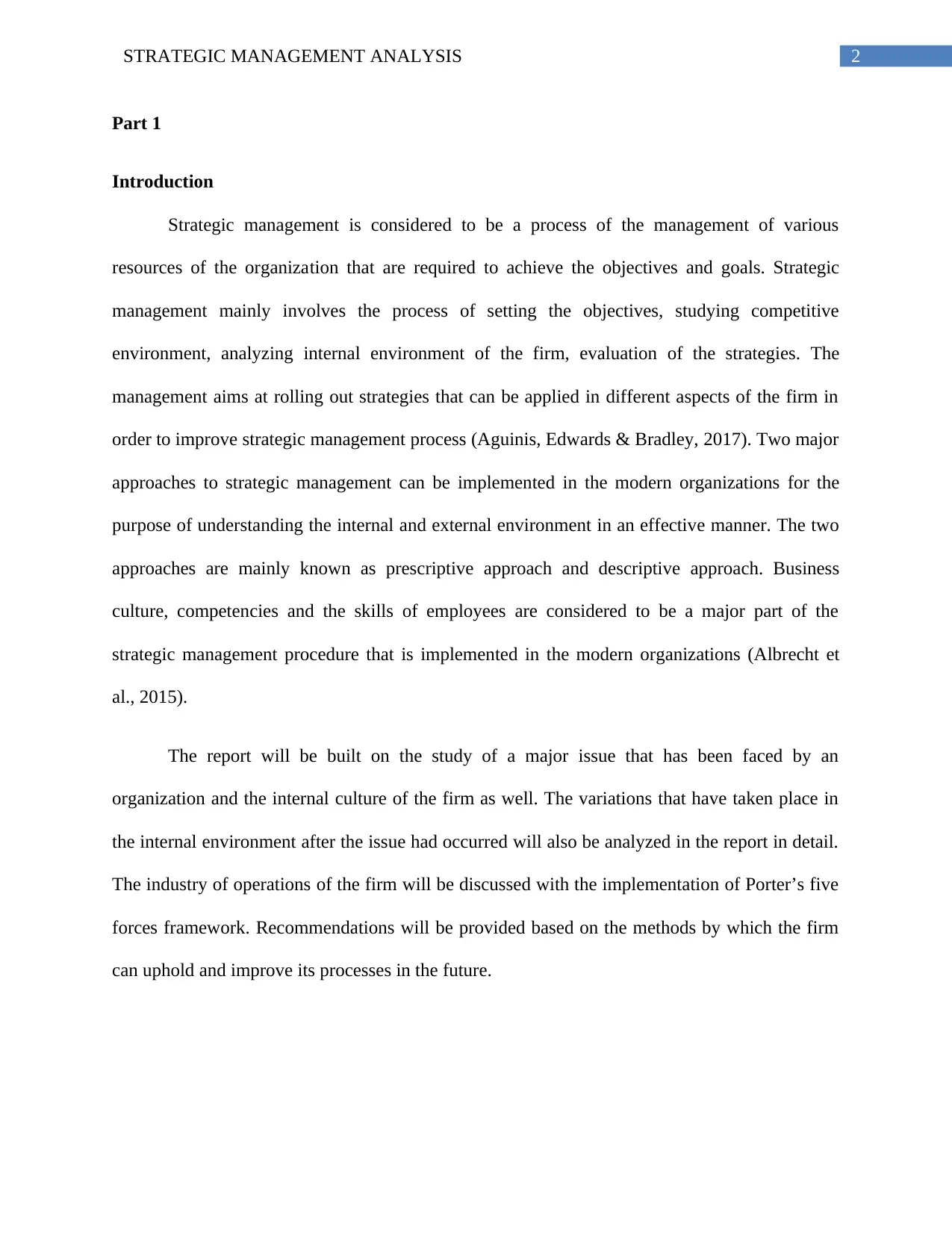
2STRATEGIC MANAGEMENT ANALYSIS
Part 1
Introduction
Strategic management is considered to be a process of the management of various
resources of the organization that are required to achieve the objectives and goals. Strategic
management mainly involves the process of setting the objectives, studying competitive
environment, analyzing internal environment of the firm, evaluation of the strategies. The
management aims at rolling out strategies that can be applied in different aspects of the firm in
order to improve strategic management process (Aguinis, Edwards & Bradley, 2017). Two major
approaches to strategic management can be implemented in the modern organizations for the
purpose of understanding the internal and external environment in an effective manner. The two
approaches are mainly known as prescriptive approach and descriptive approach. Business
culture, competencies and the skills of employees are considered to be a major part of the
strategic management procedure that is implemented in the modern organizations (Albrecht et
al., 2015).
The report will be built on the study of a major issue that has been faced by an
organization and the internal culture of the firm as well. The variations that have taken place in
the internal environment after the issue had occurred will also be analyzed in the report in detail.
The industry of operations of the firm will be discussed with the implementation of Porter’s five
forces framework. Recommendations will be provided based on the methods by which the firm
can uphold and improve its processes in the future.
Part 1
Introduction
Strategic management is considered to be a process of the management of various
resources of the organization that are required to achieve the objectives and goals. Strategic
management mainly involves the process of setting the objectives, studying competitive
environment, analyzing internal environment of the firm, evaluation of the strategies. The
management aims at rolling out strategies that can be applied in different aspects of the firm in
order to improve strategic management process (Aguinis, Edwards & Bradley, 2017). Two major
approaches to strategic management can be implemented in the modern organizations for the
purpose of understanding the internal and external environment in an effective manner. The two
approaches are mainly known as prescriptive approach and descriptive approach. Business
culture, competencies and the skills of employees are considered to be a major part of the
strategic management procedure that is implemented in the modern organizations (Albrecht et
al., 2015).
The report will be built on the study of a major issue that has been faced by an
organization and the internal culture of the firm as well. The variations that have taken place in
the internal environment after the issue had occurred will also be analyzed in the report in detail.
The industry of operations of the firm will be discussed with the implementation of Porter’s five
forces framework. Recommendations will be provided based on the methods by which the firm
can uphold and improve its processes in the future.
⊘ This is a preview!⊘
Do you want full access?
Subscribe today to unlock all pages.

Trusted by 1+ million students worldwide
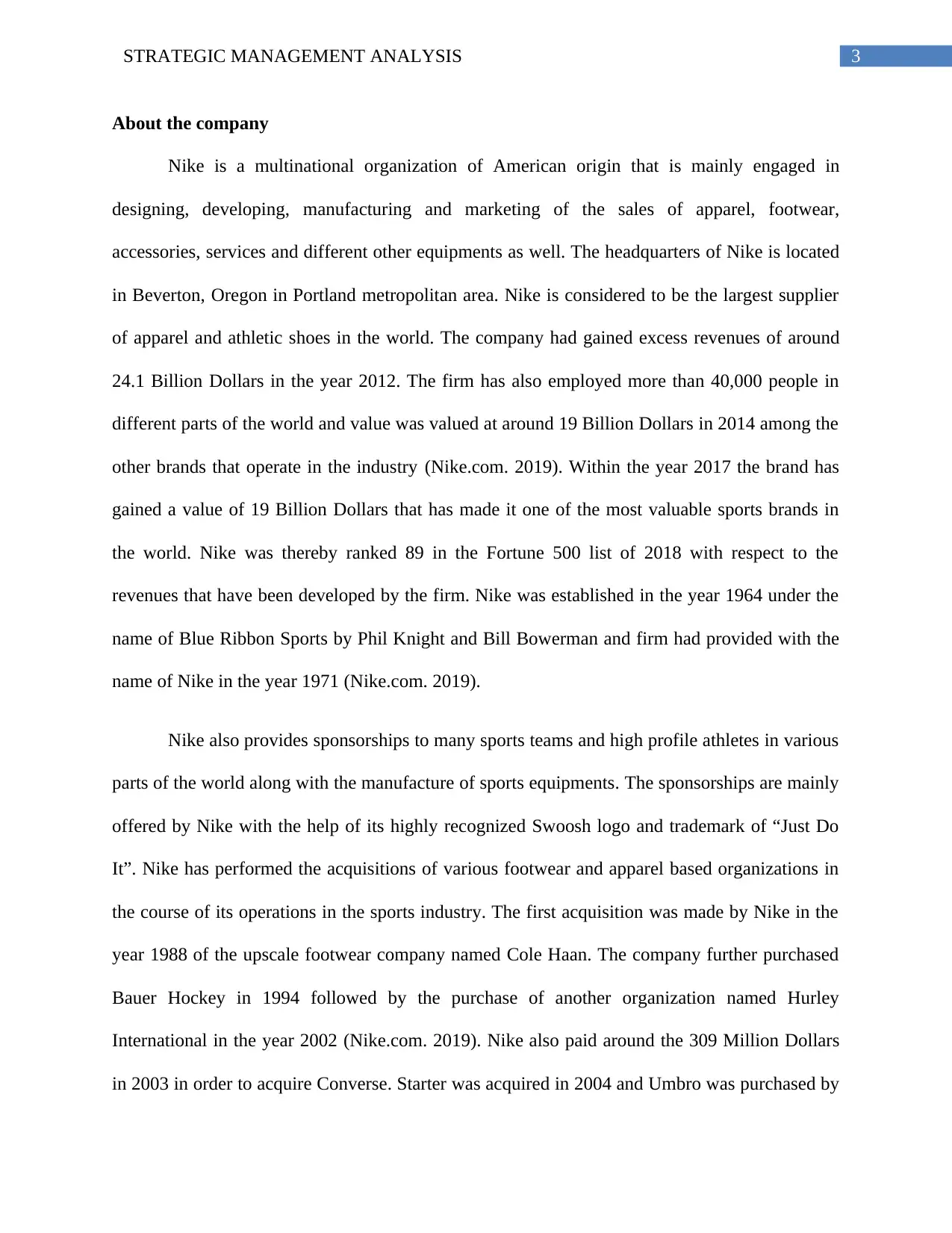
3STRATEGIC MANAGEMENT ANALYSIS
About the company
Nike is a multinational organization of American origin that is mainly engaged in
designing, developing, manufacturing and marketing of the sales of apparel, footwear,
accessories, services and different other equipments as well. The headquarters of Nike is located
in Beverton, Oregon in Portland metropolitan area. Nike is considered to be the largest supplier
of apparel and athletic shoes in the world. The company had gained excess revenues of around
24.1 Billion Dollars in the year 2012. The firm has also employed more than 40,000 people in
different parts of the world and value was valued at around 19 Billion Dollars in 2014 among the
other brands that operate in the industry (Nike.com. 2019). Within the year 2017 the brand has
gained a value of 19 Billion Dollars that has made it one of the most valuable sports brands in
the world. Nike was thereby ranked 89 in the Fortune 500 list of 2018 with respect to the
revenues that have been developed by the firm. Nike was established in the year 1964 under the
name of Blue Ribbon Sports by Phil Knight and Bill Bowerman and firm had provided with the
name of Nike in the year 1971 (Nike.com. 2019).
Nike also provides sponsorships to many sports teams and high profile athletes in various
parts of the world along with the manufacture of sports equipments. The sponsorships are mainly
offered by Nike with the help of its highly recognized Swoosh logo and trademark of “Just Do
It”. Nike has performed the acquisitions of various footwear and apparel based organizations in
the course of its operations in the sports industry. The first acquisition was made by Nike in the
year 1988 of the upscale footwear company named Cole Haan. The company further purchased
Bauer Hockey in 1994 followed by the purchase of another organization named Hurley
International in the year 2002 (Nike.com. 2019). Nike also paid around the 309 Million Dollars
in 2003 in order to acquire Converse. Starter was acquired in 2004 and Umbro was purchased by
About the company
Nike is a multinational organization of American origin that is mainly engaged in
designing, developing, manufacturing and marketing of the sales of apparel, footwear,
accessories, services and different other equipments as well. The headquarters of Nike is located
in Beverton, Oregon in Portland metropolitan area. Nike is considered to be the largest supplier
of apparel and athletic shoes in the world. The company had gained excess revenues of around
24.1 Billion Dollars in the year 2012. The firm has also employed more than 40,000 people in
different parts of the world and value was valued at around 19 Billion Dollars in 2014 among the
other brands that operate in the industry (Nike.com. 2019). Within the year 2017 the brand has
gained a value of 19 Billion Dollars that has made it one of the most valuable sports brands in
the world. Nike was thereby ranked 89 in the Fortune 500 list of 2018 with respect to the
revenues that have been developed by the firm. Nike was established in the year 1964 under the
name of Blue Ribbon Sports by Phil Knight and Bill Bowerman and firm had provided with the
name of Nike in the year 1971 (Nike.com. 2019).
Nike also provides sponsorships to many sports teams and high profile athletes in various
parts of the world along with the manufacture of sports equipments. The sponsorships are mainly
offered by Nike with the help of its highly recognized Swoosh logo and trademark of “Just Do
It”. Nike has performed the acquisitions of various footwear and apparel based organizations in
the course of its operations in the sports industry. The first acquisition was made by Nike in the
year 1988 of the upscale footwear company named Cole Haan. The company further purchased
Bauer Hockey in 1994 followed by the purchase of another organization named Hurley
International in the year 2002 (Nike.com. 2019). Nike also paid around the 309 Million Dollars
in 2003 in order to acquire Converse. Starter was acquired in 2004 and Umbro was purchased by
Paraphrase This Document
Need a fresh take? Get an instant paraphrase of this document with our AI Paraphraser
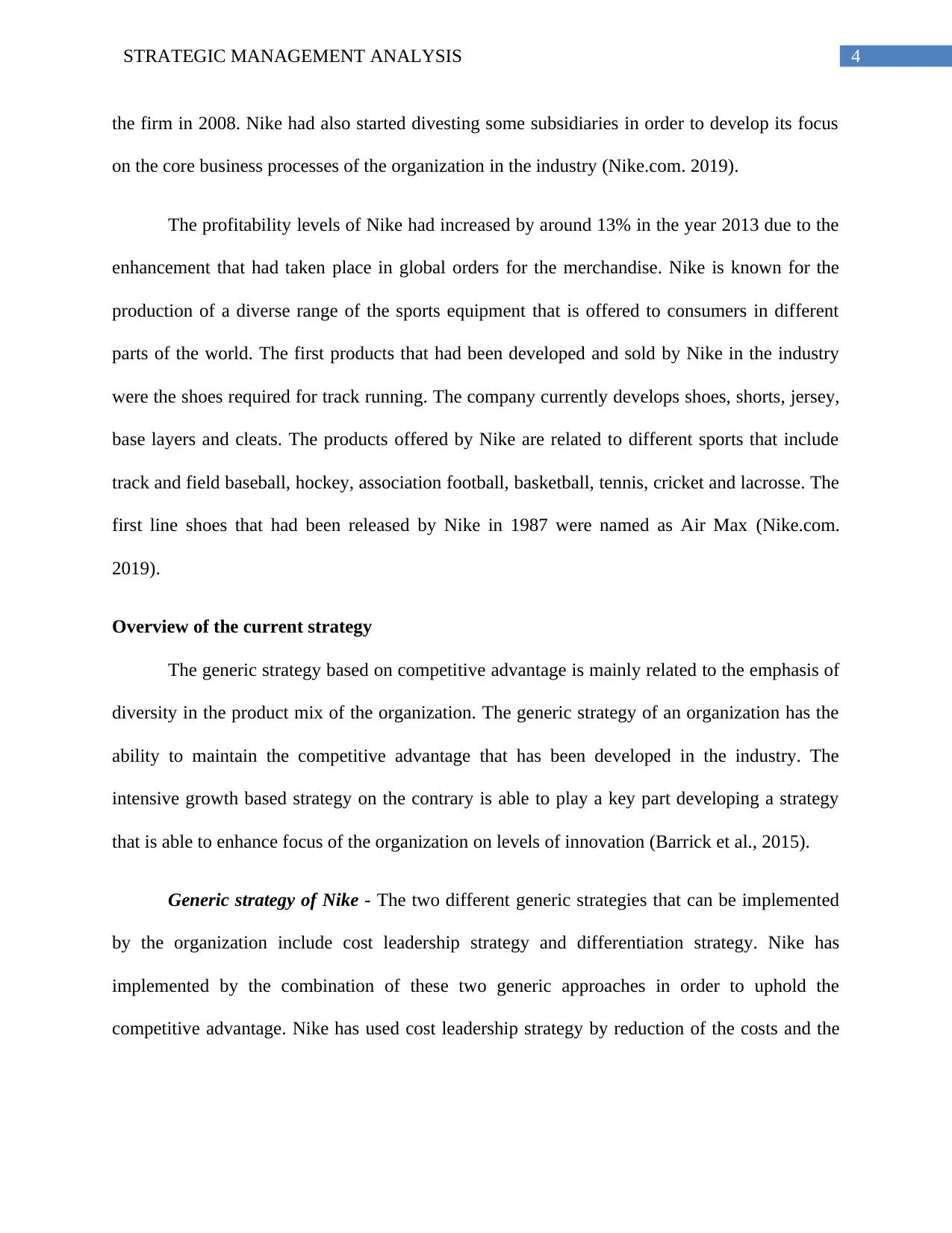
4STRATEGIC MANAGEMENT ANALYSIS
the firm in 2008. Nike had also started divesting some subsidiaries in order to develop its focus
on the core business processes of the organization in the industry (Nike.com. 2019).
The profitability levels of Nike had increased by around 13% in the year 2013 due to the
enhancement that had taken place in global orders for the merchandise. Nike is known for the
production of a diverse range of the sports equipment that is offered to consumers in different
parts of the world. The first products that had been developed and sold by Nike in the industry
were the shoes required for track running. The company currently develops shoes, shorts, jersey,
base layers and cleats. The products offered by Nike are related to different sports that include
track and field baseball, hockey, association football, basketball, tennis, cricket and lacrosse. The
first line shoes that had been released by Nike in 1987 were named as Air Max (Nike.com.
2019).
Overview of the current strategy
The generic strategy based on competitive advantage is mainly related to the emphasis of
diversity in the product mix of the organization. The generic strategy of an organization has the
ability to maintain the competitive advantage that has been developed in the industry. The
intensive growth based strategy on the contrary is able to play a key part developing a strategy
that is able to enhance focus of the organization on levels of innovation (Barrick et al., 2015).
Generic strategy of Nike - The two different generic strategies that can be implemented
by the organization include cost leadership strategy and differentiation strategy. Nike has
implemented by the combination of these two generic approaches in order to uphold the
competitive advantage. Nike has used cost leadership strategy by reduction of the costs and the
the firm in 2008. Nike had also started divesting some subsidiaries in order to develop its focus
on the core business processes of the organization in the industry (Nike.com. 2019).
The profitability levels of Nike had increased by around 13% in the year 2013 due to the
enhancement that had taken place in global orders for the merchandise. Nike is known for the
production of a diverse range of the sports equipment that is offered to consumers in different
parts of the world. The first products that had been developed and sold by Nike in the industry
were the shoes required for track running. The company currently develops shoes, shorts, jersey,
base layers and cleats. The products offered by Nike are related to different sports that include
track and field baseball, hockey, association football, basketball, tennis, cricket and lacrosse. The
first line shoes that had been released by Nike in 1987 were named as Air Max (Nike.com.
2019).
Overview of the current strategy
The generic strategy based on competitive advantage is mainly related to the emphasis of
diversity in the product mix of the organization. The generic strategy of an organization has the
ability to maintain the competitive advantage that has been developed in the industry. The
intensive growth based strategy on the contrary is able to play a key part developing a strategy
that is able to enhance focus of the organization on levels of innovation (Barrick et al., 2015).
Generic strategy of Nike - The two different generic strategies that can be implemented
by the organization include cost leadership strategy and differentiation strategy. Nike has
implemented by the combination of these two generic approaches in order to uphold the
competitive advantage. Nike has used cost leadership strategy by reduction of the costs and the
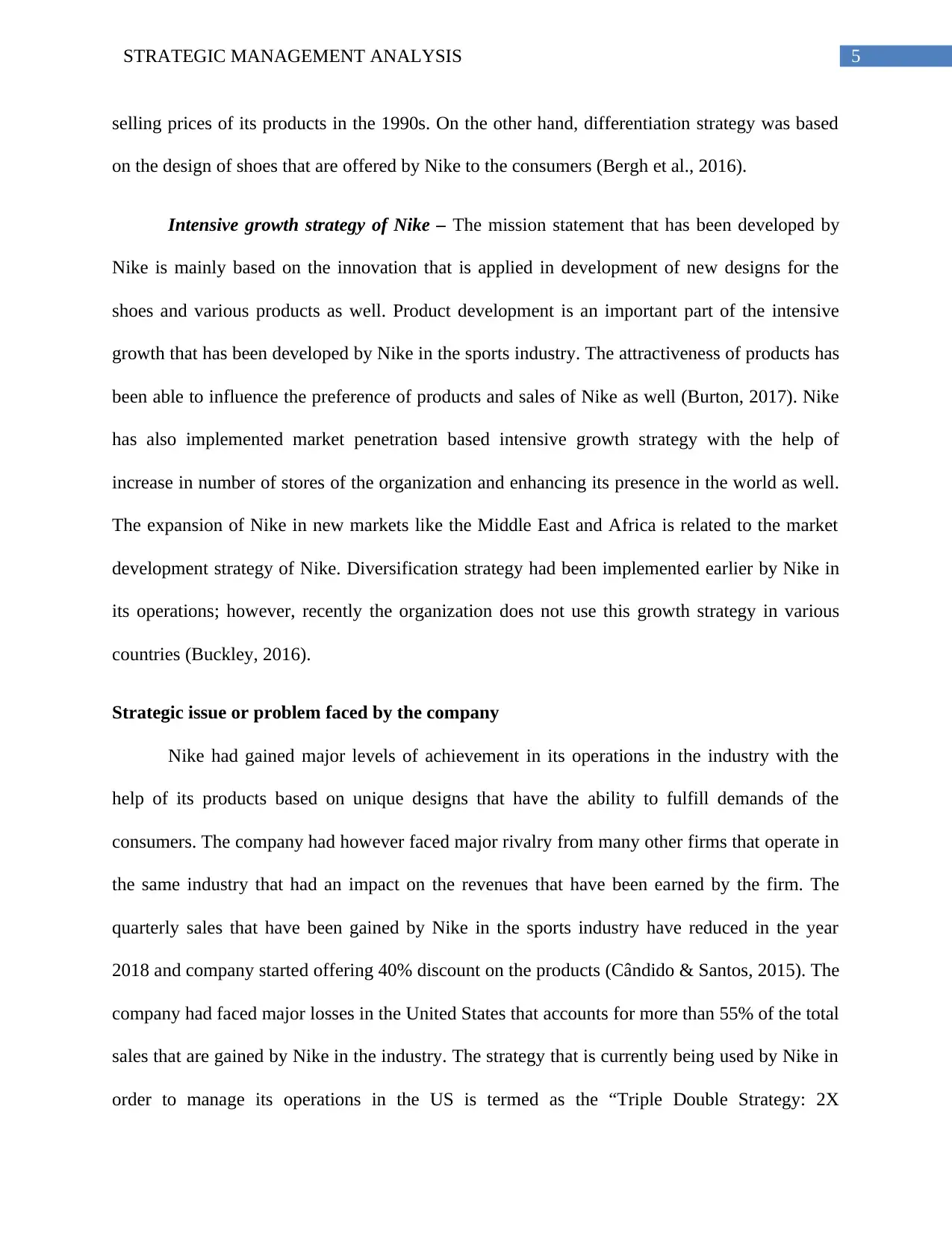
5STRATEGIC MANAGEMENT ANALYSIS
selling prices of its products in the 1990s. On the other hand, differentiation strategy was based
on the design of shoes that are offered by Nike to the consumers (Bergh et al., 2016).
Intensive growth strategy of Nike – The mission statement that has been developed by
Nike is mainly based on the innovation that is applied in development of new designs for the
shoes and various products as well. Product development is an important part of the intensive
growth that has been developed by Nike in the sports industry. The attractiveness of products has
been able to influence the preference of products and sales of Nike as well (Burton, 2017). Nike
has also implemented market penetration based intensive growth strategy with the help of
increase in number of stores of the organization and enhancing its presence in the world as well.
The expansion of Nike in new markets like the Middle East and Africa is related to the market
development strategy of Nike. Diversification strategy had been implemented earlier by Nike in
its operations; however, recently the organization does not use this growth strategy in various
countries (Buckley, 2016).
Strategic issue or problem faced by the company
Nike had gained major levels of achievement in its operations in the industry with the
help of its products based on unique designs that have the ability to fulfill demands of the
consumers. The company had however faced major rivalry from many other firms that operate in
the same industry that had an impact on the revenues that have been earned by the firm. The
quarterly sales that have been gained by Nike in the sports industry have reduced in the year
2018 and company started offering 40% discount on the products (Cândido & Santos, 2015). The
company had faced major losses in the United States that accounts for more than 55% of the total
sales that are gained by Nike in the industry. The strategy that is currently being used by Nike in
order to manage its operations in the US is termed as the “Triple Double Strategy: 2X
selling prices of its products in the 1990s. On the other hand, differentiation strategy was based
on the design of shoes that are offered by Nike to the consumers (Bergh et al., 2016).
Intensive growth strategy of Nike – The mission statement that has been developed by
Nike is mainly based on the innovation that is applied in development of new designs for the
shoes and various products as well. Product development is an important part of the intensive
growth that has been developed by Nike in the sports industry. The attractiveness of products has
been able to influence the preference of products and sales of Nike as well (Burton, 2017). Nike
has also implemented market penetration based intensive growth strategy with the help of
increase in number of stores of the organization and enhancing its presence in the world as well.
The expansion of Nike in new markets like the Middle East and Africa is related to the market
development strategy of Nike. Diversification strategy had been implemented earlier by Nike in
its operations; however, recently the organization does not use this growth strategy in various
countries (Buckley, 2016).
Strategic issue or problem faced by the company
Nike had gained major levels of achievement in its operations in the industry with the
help of its products based on unique designs that have the ability to fulfill demands of the
consumers. The company had however faced major rivalry from many other firms that operate in
the same industry that had an impact on the revenues that have been earned by the firm. The
quarterly sales that have been gained by Nike in the sports industry have reduced in the year
2018 and company started offering 40% discount on the products (Cândido & Santos, 2015). The
company had faced major losses in the United States that accounts for more than 55% of the total
sales that are gained by Nike in the industry. The strategy that is currently being used by Nike in
order to manage its operations in the US is termed as the “Triple Double Strategy: 2X
⊘ This is a preview!⊘
Do you want full access?
Subscribe today to unlock all pages.

Trusted by 1+ million students worldwide

6STRATEGIC MANAGEMENT ANALYSIS
innovation, 2X Direct and 2X Speed” (Forbes.com. 2019). The company had been riding quite
high on the various aspirations of the urban youth for their choices of footwear. However, Nike
had started losing ground due to the lack of interest related to its products within the core base
(CARTWRIGHT & Cooper, 2016).
The products like Supreme and Vans in the Streetwear and the companies like Puma,
Adidas and New Balance have started gaining momentum in the last few years. Nike thereby
plans to continue the partnership that had been developed with NBA by providing them with the
high performance based sneakers like Jordan Brand and KYRIE 3. The company had also
enhanced its product offerings in order to provide the basketball-themed apparel offerings. The
product based initiatives that have been implemented by Nike have been quite effective for the
organization (Chatterji et al., 2016). However, the sales of products of Nike have not been
affected in a huge way by the changes that have been made by the organization within the
products that are provided to the consumers. The structural changes that have taken place in the
sports industry have a major impact on the performances that are depicted by the various
organizations that are a part of the industry. Increasing levels of competition faced by Nike have
been able to act as major issues that have an impact on the sales and revenues that have been
gained by the firm (Collings, Wood & Szamosi, 2018).
Part 2
Overview of the industry
Sports have been an important part of the culture that has been developed and is followed
in the United States. The professional sports like basketball, football, hockey and baseball. The
growth of youth in the country is also influenced in a huge manner by sports that have been
innovation, 2X Direct and 2X Speed” (Forbes.com. 2019). The company had been riding quite
high on the various aspirations of the urban youth for their choices of footwear. However, Nike
had started losing ground due to the lack of interest related to its products within the core base
(CARTWRIGHT & Cooper, 2016).
The products like Supreme and Vans in the Streetwear and the companies like Puma,
Adidas and New Balance have started gaining momentum in the last few years. Nike thereby
plans to continue the partnership that had been developed with NBA by providing them with the
high performance based sneakers like Jordan Brand and KYRIE 3. The company had also
enhanced its product offerings in order to provide the basketball-themed apparel offerings. The
product based initiatives that have been implemented by Nike have been quite effective for the
organization (Chatterji et al., 2016). However, the sales of products of Nike have not been
affected in a huge way by the changes that have been made by the organization within the
products that are provided to the consumers. The structural changes that have taken place in the
sports industry have a major impact on the performances that are depicted by the various
organizations that are a part of the industry. Increasing levels of competition faced by Nike have
been able to act as major issues that have an impact on the sales and revenues that have been
gained by the firm (Collings, Wood & Szamosi, 2018).
Part 2
Overview of the industry
Sports have been an important part of the culture that has been developed and is followed
in the United States. The professional sports like basketball, football, hockey and baseball. The
growth of youth in the country is also influenced in a huge manner by sports that have been
Paraphrase This Document
Need a fresh take? Get an instant paraphrase of this document with our AI Paraphraser

7STRATEGIC MANAGEMENT ANALYSIS
developed in the US. Popularity of the sports based activities has been able to the play a key part
in the history of the country. Baseball is considered to be the national pastime in America for
many years (DeGaris, 2015).
Competitive analysis of sports industry
Sports are considered to be a complex and multi-faceted activity that encompasses the
modern spectacles like Winter Olympics games and Summer games as well. The first major step
that is implemented in process of estimating economic scope of the industry is based on the
methods by which a particular sport is defined. A major issue related to defining the sport mainly
involves the ways by the criteria of the sports can be identified in an effective manner. The sports
apparel market is influenced in a huge manner due to variations that have taken place in the
fashion trends and the rising health consciousness as well (Felix, Rauschnabel & Hinsch, 2017).
The consumer tastes and lifestyles of the people in the US have also started varying in the last
few years. Participation of the youth in sports based activities have started increasing based on
the global media based coverage. The involvement of women in the sports activities have also
started increasing and this has enhanced the demands for various products that are offered by
organizations in the industry. The global sports apparel industry has been dominated in a huge
way by North America in the last few years. The major players in the industry include Adidas
AG, Under Armour Inc. and many more (Foster, O'Reilly & Dávila, 2016).
Structure, culture and leadership analysis of the company
Organizational structure of Nike Inc. - The structure that has been implemented in Nike
is flat in nature and is based on the two major business hierarchies that are, the traditional
hierarchies in which the people are able to report to one leader and the products hierarchies in
which the teams have been divided based on different products. The flat setup that has been
developed in the US. Popularity of the sports based activities has been able to the play a key part
in the history of the country. Baseball is considered to be the national pastime in America for
many years (DeGaris, 2015).
Competitive analysis of sports industry
Sports are considered to be a complex and multi-faceted activity that encompasses the
modern spectacles like Winter Olympics games and Summer games as well. The first major step
that is implemented in process of estimating economic scope of the industry is based on the
methods by which a particular sport is defined. A major issue related to defining the sport mainly
involves the ways by the criteria of the sports can be identified in an effective manner. The sports
apparel market is influenced in a huge manner due to variations that have taken place in the
fashion trends and the rising health consciousness as well (Felix, Rauschnabel & Hinsch, 2017).
The consumer tastes and lifestyles of the people in the US have also started varying in the last
few years. Participation of the youth in sports based activities have started increasing based on
the global media based coverage. The involvement of women in the sports activities have also
started increasing and this has enhanced the demands for various products that are offered by
organizations in the industry. The global sports apparel industry has been dominated in a huge
way by North America in the last few years. The major players in the industry include Adidas
AG, Under Armour Inc. and many more (Foster, O'Reilly & Dávila, 2016).
Structure, culture and leadership analysis of the company
Organizational structure of Nike Inc. - The structure that has been implemented in Nike
is flat in nature and is based on the two major business hierarchies that are, the traditional
hierarchies in which the people are able to report to one leader and the products hierarchies in
which the teams have been divided based on different products. The flat setup that has been
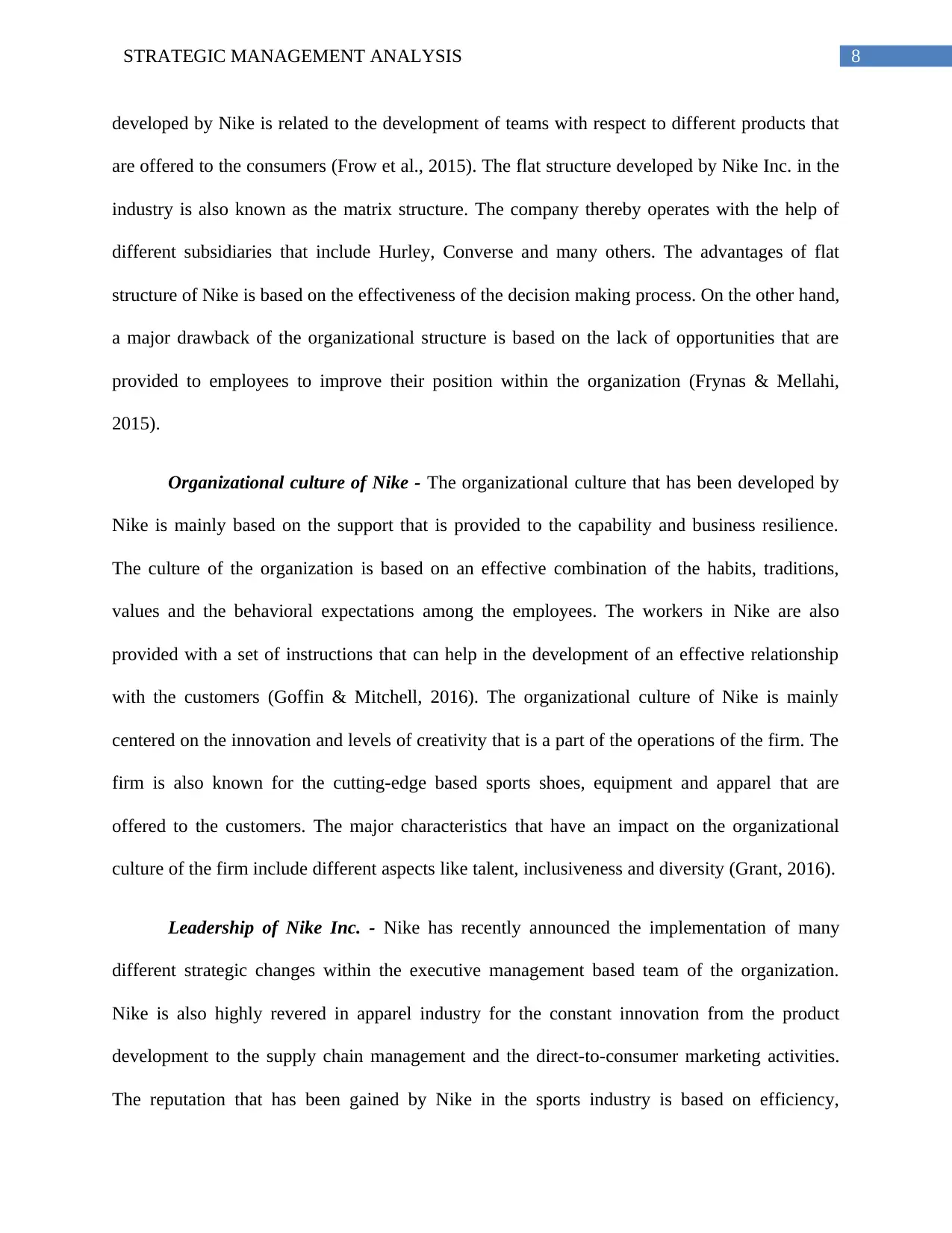
8STRATEGIC MANAGEMENT ANALYSIS
developed by Nike is related to the development of teams with respect to different products that
are offered to the consumers (Frow et al., 2015). The flat structure developed by Nike Inc. in the
industry is also known as the matrix structure. The company thereby operates with the help of
different subsidiaries that include Hurley, Converse and many others. The advantages of flat
structure of Nike is based on the effectiveness of the decision making process. On the other hand,
a major drawback of the organizational structure is based on the lack of opportunities that are
provided to employees to improve their position within the organization (Frynas & Mellahi,
2015).
Organizational culture of Nike - The organizational culture that has been developed by
Nike is mainly based on the support that is provided to the capability and business resilience.
The culture of the organization is based on an effective combination of the habits, traditions,
values and the behavioral expectations among the employees. The workers in Nike are also
provided with a set of instructions that can help in the development of an effective relationship
with the customers (Goffin & Mitchell, 2016). The organizational culture of Nike is mainly
centered on the innovation and levels of creativity that is a part of the operations of the firm. The
firm is also known for the cutting-edge based sports shoes, equipment and apparel that are
offered to the customers. The major characteristics that have an impact on the organizational
culture of the firm include different aspects like talent, inclusiveness and diversity (Grant, 2016).
Leadership of Nike Inc. - Nike has recently announced the implementation of many
different strategic changes within the executive management based team of the organization.
Nike is also highly revered in apparel industry for the constant innovation from the product
development to the supply chain management and the direct-to-consumer marketing activities.
The reputation that has been gained by Nike in the sports industry is based on efficiency,
developed by Nike is related to the development of teams with respect to different products that
are offered to the consumers (Frow et al., 2015). The flat structure developed by Nike Inc. in the
industry is also known as the matrix structure. The company thereby operates with the help of
different subsidiaries that include Hurley, Converse and many others. The advantages of flat
structure of Nike is based on the effectiveness of the decision making process. On the other hand,
a major drawback of the organizational structure is based on the lack of opportunities that are
provided to employees to improve their position within the organization (Frynas & Mellahi,
2015).
Organizational culture of Nike - The organizational culture that has been developed by
Nike is mainly based on the support that is provided to the capability and business resilience.
The culture of the organization is based on an effective combination of the habits, traditions,
values and the behavioral expectations among the employees. The workers in Nike are also
provided with a set of instructions that can help in the development of an effective relationship
with the customers (Goffin & Mitchell, 2016). The organizational culture of Nike is mainly
centered on the innovation and levels of creativity that is a part of the operations of the firm. The
firm is also known for the cutting-edge based sports shoes, equipment and apparel that are
offered to the customers. The major characteristics that have an impact on the organizational
culture of the firm include different aspects like talent, inclusiveness and diversity (Grant, 2016).
Leadership of Nike Inc. - Nike has recently announced the implementation of many
different strategic changes within the executive management based team of the organization.
Nike is also highly revered in apparel industry for the constant innovation from the product
development to the supply chain management and the direct-to-consumer marketing activities.
The reputation that has been gained by Nike in the sports industry is based on efficiency,
⊘ This is a preview!⊘
Do you want full access?
Subscribe today to unlock all pages.

Trusted by 1+ million students worldwide
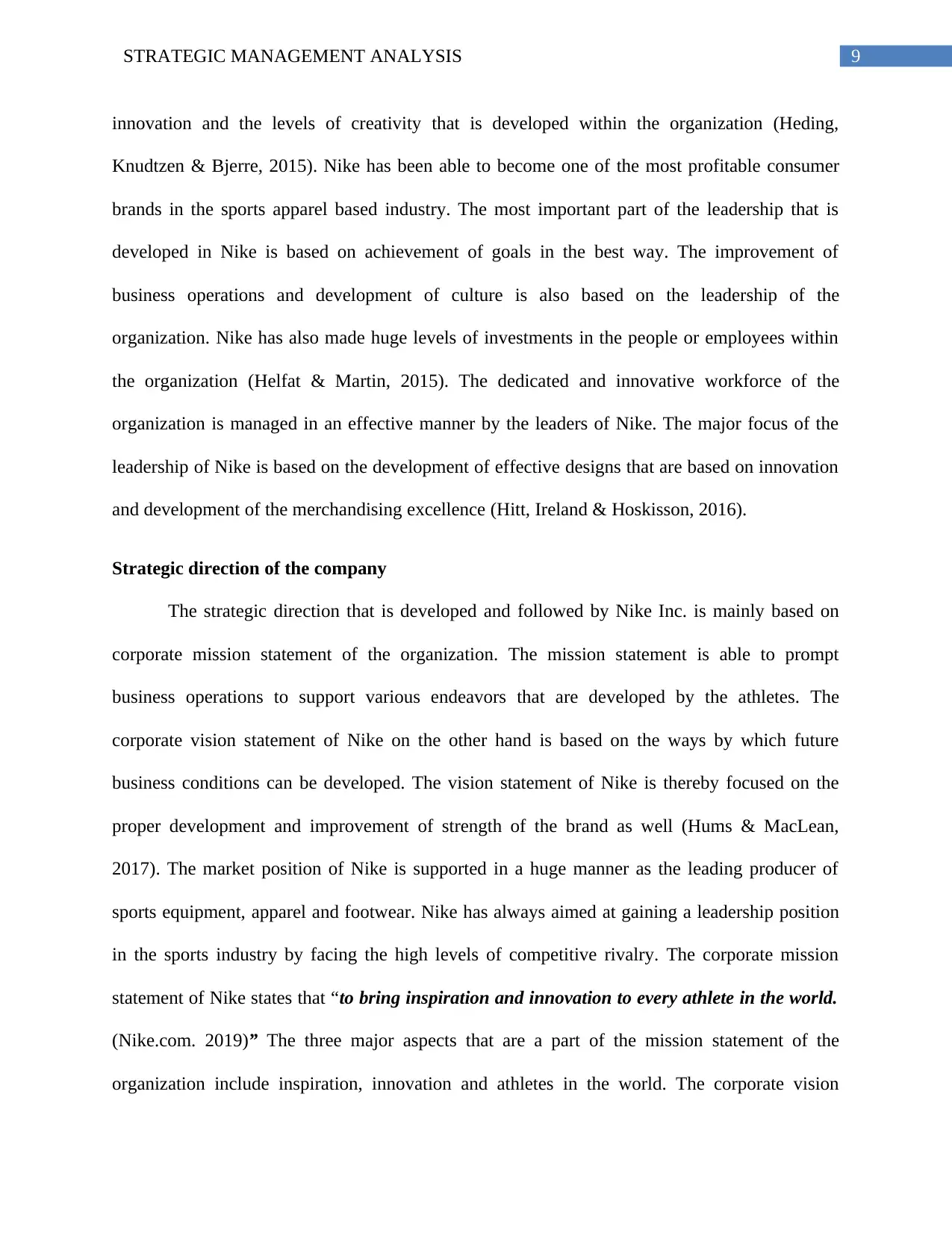
9STRATEGIC MANAGEMENT ANALYSIS
innovation and the levels of creativity that is developed within the organization (Heding,
Knudtzen & Bjerre, 2015). Nike has been able to become one of the most profitable consumer
brands in the sports apparel based industry. The most important part of the leadership that is
developed in Nike is based on achievement of goals in the best way. The improvement of
business operations and development of culture is also based on the leadership of the
organization. Nike has also made huge levels of investments in the people or employees within
the organization (Helfat & Martin, 2015). The dedicated and innovative workforce of the
organization is managed in an effective manner by the leaders of Nike. The major focus of the
leadership of Nike is based on the development of effective designs that are based on innovation
and development of the merchandising excellence (Hitt, Ireland & Hoskisson, 2016).
Strategic direction of the company
The strategic direction that is developed and followed by Nike Inc. is mainly based on
corporate mission statement of the organization. The mission statement is able to prompt
business operations to support various endeavors that are developed by the athletes. The
corporate vision statement of Nike on the other hand is based on the ways by which future
business conditions can be developed. The vision statement of Nike is thereby focused on the
proper development and improvement of strength of the brand as well (Hums & MacLean,
2017). The market position of Nike is supported in a huge manner as the leading producer of
sports equipment, apparel and footwear. Nike has always aimed at gaining a leadership position
in the sports industry by facing the high levels of competitive rivalry. The corporate mission
statement of Nike states that “to bring inspiration and innovation to every athlete in the world.
(Nike.com. 2019)” The three major aspects that are a part of the mission statement of the
organization include inspiration, innovation and athletes in the world. The corporate vision
innovation and the levels of creativity that is developed within the organization (Heding,
Knudtzen & Bjerre, 2015). Nike has been able to become one of the most profitable consumer
brands in the sports apparel based industry. The most important part of the leadership that is
developed in Nike is based on achievement of goals in the best way. The improvement of
business operations and development of culture is also based on the leadership of the
organization. Nike has also made huge levels of investments in the people or employees within
the organization (Helfat & Martin, 2015). The dedicated and innovative workforce of the
organization is managed in an effective manner by the leaders of Nike. The major focus of the
leadership of Nike is based on the development of effective designs that are based on innovation
and development of the merchandising excellence (Hitt, Ireland & Hoskisson, 2016).
Strategic direction of the company
The strategic direction that is developed and followed by Nike Inc. is mainly based on
corporate mission statement of the organization. The mission statement is able to prompt
business operations to support various endeavors that are developed by the athletes. The
corporate vision statement of Nike on the other hand is based on the ways by which future
business conditions can be developed. The vision statement of Nike is thereby focused on the
proper development and improvement of strength of the brand as well (Hums & MacLean,
2017). The market position of Nike is supported in a huge manner as the leading producer of
sports equipment, apparel and footwear. Nike has always aimed at gaining a leadership position
in the sports industry by facing the high levels of competitive rivalry. The corporate mission
statement of Nike states that “to bring inspiration and innovation to every athlete in the world.
(Nike.com. 2019)” The three major aspects that are a part of the mission statement of the
organization include inspiration, innovation and athletes in the world. The corporate vision
Paraphrase This Document
Need a fresh take? Get an instant paraphrase of this document with our AI Paraphraser

10STRATEGIC MANAGEMENT ANALYSIS
statement of Nike Inc. on the other hand states that “to remain the most authentic, connected,
and distinctive brand. (Nike.com. 2019)” Major aspects that have an impact on the vision
statement include authenticity, connectedness distinctiveness and attractiveness (Jarzabkowski &
Kaplan, 2015).
Company Situational analysis
Porter’s five forces analysis of the company
Competitive rivalry – Competition is able to play a key part in the methods by which
Nike aims at maintaining the share that is gained in the sports footwear based market. The
industry environment in which Nike operates is also affected in a huge way by the force of
competitive rivalry. The low growth rates of the market is considered to be a strong force that is
able to influence the competition that is faced by Nike Inc. The firms that are operating in the
sports footwear and apparel industry are considered to be highly aggressive in nature. This is
able to boost levels of competition that are faced by the organizations based on gaining the
shares in the market (Jiang, Luo & Kulemeka, 2017).
Bargaining power of the customers – The switching costs related to purchase of the
products in sports apparel industry are quite low and the buyers have been provided with many
options by the different organizations. The availability of substitute products is considered to be
a vital part of the processes that are developed by Nike. The size of individual buyers in the
industry is quite low and has less impact on Nike and its operations. The force related to
bargaining power that is developed by the buyers is quite moderate (Kim, Chiu & Chow, 2019).
Bargaining power of the suppliers – The supply chain that is developed by Nike in the
sports industry is highly effective in nature. The impact of individual buyers on the business
statement of Nike Inc. on the other hand states that “to remain the most authentic, connected,
and distinctive brand. (Nike.com. 2019)” Major aspects that have an impact on the vision
statement include authenticity, connectedness distinctiveness and attractiveness (Jarzabkowski &
Kaplan, 2015).
Company Situational analysis
Porter’s five forces analysis of the company
Competitive rivalry – Competition is able to play a key part in the methods by which
Nike aims at maintaining the share that is gained in the sports footwear based market. The
industry environment in which Nike operates is also affected in a huge way by the force of
competitive rivalry. The low growth rates of the market is considered to be a strong force that is
able to influence the competition that is faced by Nike Inc. The firms that are operating in the
sports footwear and apparel industry are considered to be highly aggressive in nature. This is
able to boost levels of competition that are faced by the organizations based on gaining the
shares in the market (Jiang, Luo & Kulemeka, 2017).
Bargaining power of the customers – The switching costs related to purchase of the
products in sports apparel industry are quite low and the buyers have been provided with many
options by the different organizations. The availability of substitute products is considered to be
a vital part of the processes that are developed by Nike. The size of individual buyers in the
industry is quite low and has less impact on Nike and its operations. The force related to
bargaining power that is developed by the buyers is quite moderate (Kim, Chiu & Chow, 2019).
Bargaining power of the suppliers – The supply chain that is developed by Nike in the
sports industry is highly effective in nature. The impact of individual buyers on the business
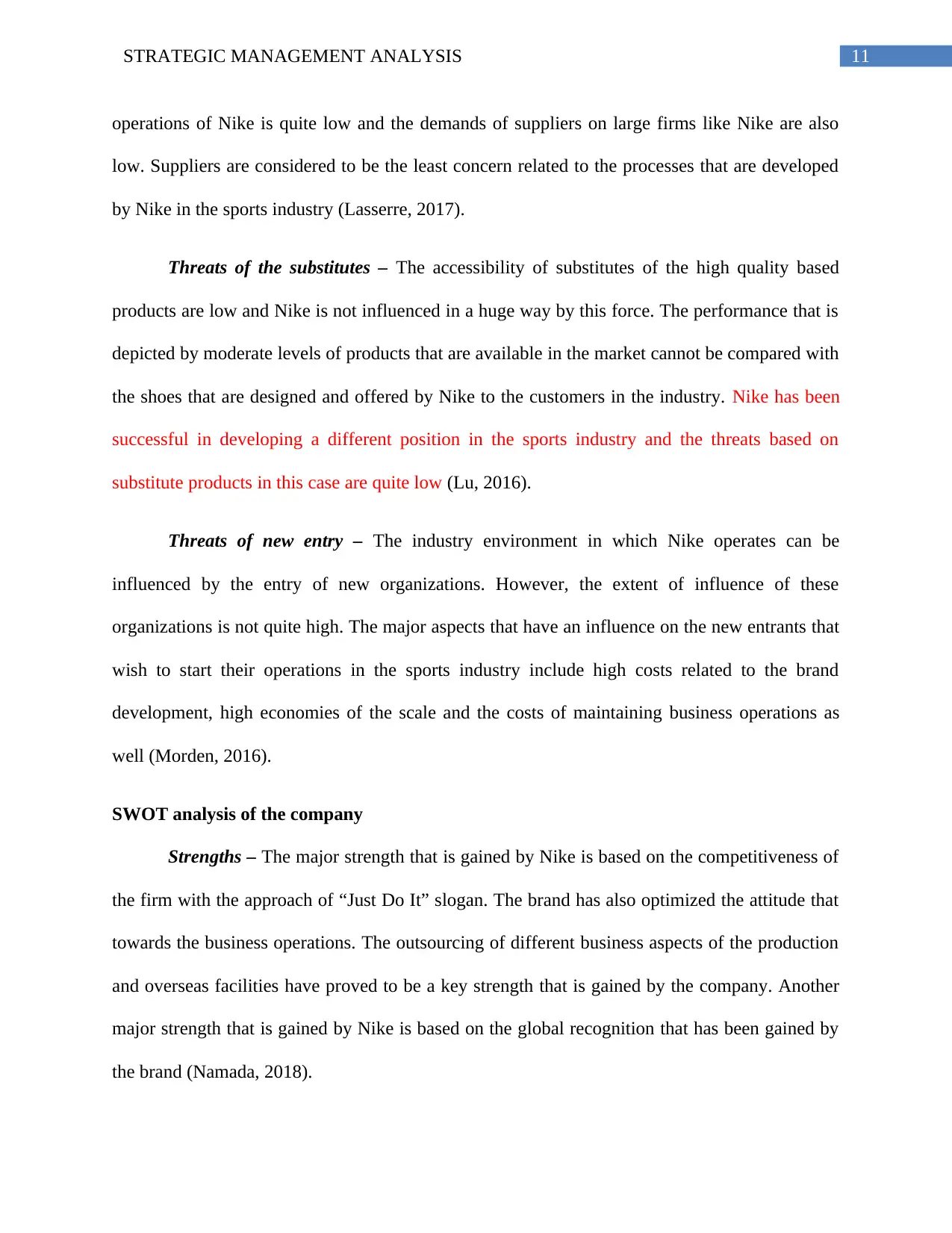
11STRATEGIC MANAGEMENT ANALYSIS
operations of Nike is quite low and the demands of suppliers on large firms like Nike are also
low. Suppliers are considered to be the least concern related to the processes that are developed
by Nike in the sports industry (Lasserre, 2017).
Threats of the substitutes – The accessibility of substitutes of the high quality based
products are low and Nike is not influenced in a huge way by this force. The performance that is
depicted by moderate levels of products that are available in the market cannot be compared with
the shoes that are designed and offered by Nike to the customers in the industry. Nike has been
successful in developing a different position in the sports industry and the threats based on
substitute products in this case are quite low (Lu, 2016).
Threats of new entry – The industry environment in which Nike operates can be
influenced by the entry of new organizations. However, the extent of influence of these
organizations is not quite high. The major aspects that have an influence on the new entrants that
wish to start their operations in the sports industry include high costs related to the brand
development, high economies of the scale and the costs of maintaining business operations as
well (Morden, 2016).
SWOT analysis of the company
Strengths – The major strength that is gained by Nike is based on the competitiveness of
the firm with the approach of “Just Do It” slogan. The brand has also optimized the attitude that
towards the business operations. The outsourcing of different business aspects of the production
and overseas facilities have proved to be a key strength that is gained by the company. Another
major strength that is gained by Nike is based on the global recognition that has been gained by
the brand (Namada, 2018).
operations of Nike is quite low and the demands of suppliers on large firms like Nike are also
low. Suppliers are considered to be the least concern related to the processes that are developed
by Nike in the sports industry (Lasserre, 2017).
Threats of the substitutes – The accessibility of substitutes of the high quality based
products are low and Nike is not influenced in a huge way by this force. The performance that is
depicted by moderate levels of products that are available in the market cannot be compared with
the shoes that are designed and offered by Nike to the customers in the industry. Nike has been
successful in developing a different position in the sports industry and the threats based on
substitute products in this case are quite low (Lu, 2016).
Threats of new entry – The industry environment in which Nike operates can be
influenced by the entry of new organizations. However, the extent of influence of these
organizations is not quite high. The major aspects that have an influence on the new entrants that
wish to start their operations in the sports industry include high costs related to the brand
development, high economies of the scale and the costs of maintaining business operations as
well (Morden, 2016).
SWOT analysis of the company
Strengths – The major strength that is gained by Nike is based on the competitiveness of
the firm with the approach of “Just Do It” slogan. The brand has also optimized the attitude that
towards the business operations. The outsourcing of different business aspects of the production
and overseas facilities have proved to be a key strength that is gained by the company. Another
major strength that is gained by Nike is based on the global recognition that has been gained by
the brand (Namada, 2018).
⊘ This is a preview!⊘
Do you want full access?
Subscribe today to unlock all pages.

Trusted by 1+ million students worldwide
1 out of 22
Related Documents
Your All-in-One AI-Powered Toolkit for Academic Success.
+13062052269
info@desklib.com
Available 24*7 on WhatsApp / Email
![[object Object]](/_next/static/media/star-bottom.7253800d.svg)
Unlock your academic potential
Copyright © 2020–2025 A2Z Services. All Rights Reserved. Developed and managed by ZUCOL.





